Effect of Fe Element and Ultrasonic Vibration on the Microstructure and Mechanical Properties of the Cu-TiB2 Composites
Abstract
:1. Introduction
2. Materials and Methods
3. Results
4. Discussion
4.1. Effects of Fe on Microstructural Evolution and Mechanical Properties
4.2. Effects of Ultrasonic Vibration on Microstructural Evolution and Mechanical Properties
5. Conclusions
- (1)
- The combination of Fe and Ti alloying with aging treatment contributes to the enhancement of strength and elongation in Cu-TiB2 composites. The tensile strength and uniform elongation of the composite with an Fe content of 0.7 reach 511 MPa and 6.02%, respectively, achieving a comprehensive property compared with the unalloyed composite.
- (2)
- Ultrasonic vibration treatment can improve the strength and plasticity of composites simultaneously. The as-aged Cu-0.7Fe-0.3Ti-1TiB2 composite with ultrasonic vibration treatment exhibits a tensile strength and uniform elongation of 533 MPa and 7.2%, respectively, representing an increase of 4.3% and 18.9% compared to the composite without ultrasonic vibration treatment.
- (3)
- The combined effects of cavitation and acoustic flow improve the distribution of particles in the as-cast composite through ultrasonic vibration, and the TiB2 microscale particles and Fe2Ti nanoscale precipitates with uniform distribution effectively impede dislocation movement and delay recrystallization, which improves the tensile strength and stability at elevated temperature.
Supplementary Materials
Author Contributions
Funding
Data Availability Statement
Conflicts of Interest
References
- Feng, J.; Song, K.; Liang, S.; Guo, X.; Li, S. Mechanical properties and electrical conductivity of oriented-SiC-whisker-reinforced Al2O3/Cu composites. J. Mater. Res. Technol. 2022, 20, 1470–1480. [Google Scholar] [CrossRef]
- Xiao, Z.; Huang, Y.; Chen, C.; Li, Z.; Gong, S.; Huang, Y.; Zhang, C.; Zhang, X. Effects of thermal treatments on the residual stress and micro-yield strength of Al2O3 dispersion strengthened copper alloy. J. Alloys Compd. 2019, 781, 490–495. [Google Scholar] [CrossRef]
- Liang, S.; Li, W.; Jiang, Y.; Cao, F.; Dong, G.; Xiao, P. Microstructures and properties of hybrid copper matrix composites reinforced by TiB whiskers and TiB2 particles. J. Alloys Compd. 2019, 797, 589–594. [Google Scholar] [CrossRef]
- Fan, X.; Huang, X.; Liu, Q.; Ding, H.; Wang, H.; Hao, C. The microstructures and properties of in-situ ZrB2 reinforced Cu matrix composites. Results Phys. 2019, 14, 102494. [Google Scholar] [CrossRef]
- Wang, X.; Jie, J.; Liu, S.; Dong, Z.; Yin, G.; Li, T. Growth mechanism of primary Ti5Si3 phases in special brasses and their effect on wear resistance. J. Mater. Sci. Technol. 2021, 61, 138–146. [Google Scholar] [CrossRef]
- Chen, W.; Gao, G.; Meng, X.; Zhao, X.; Jiang, Y.; Wang, M.; Li, Z.; Xiao, L. Microstructure, properties and strengthening mechanism of Cu-TiB2-Al2O3 composite prepared by liquid phase in-situ reaction casting. J. Alloys Compd. 2022, 912, 165170. [Google Scholar] [CrossRef]
- Zhao, H.; Feng, Y.; Zhou, Z.; Qian, G.; Zhang, J.; Huang, X.; Zhang, X. Effect of electrical current density, apparent contact pressure, and sliding velocity on the electrical sliding wear behavior of Cu–Ti3AlC2 composites. Wear 2020, 444–445, 203156. [Google Scholar] [CrossRef]
- Bashir, K.; Gupta, D.; Jain, V. Microstructural investigation of variable tungsten reinforcement in copper-based composite microwave castings. Int. J. Metalcast. 2024. [Google Scholar] [CrossRef]
- Feng, J.; Song, K.; Liang, S.; Guo, X.; Jiang, Y. Electrical wear of TiB2 particle-reinforced Cu and Cu–Cr composites prepared by vacuum arc melting. Vacuum 2020, 175, 109295. [Google Scholar] [CrossRef]
- Cao, F.; Dong, G.; Jiang, Y.; Xiao, P.; Wang, T.; Liang, S. Effect of La addition on microstructures and properties of TiB2(-TiB)/Cu hybrid composites prepared by in situ reaction. Mater. Sci. Eng. A 2020, 789, 139605. [Google Scholar] [CrossRef]
- Kim, J.H.; Yun, J.H.; Park, Y.H.; Cho, K.M.; Choi, I.D.; Park, I.M. Manufacturing of Cu-TiB2 composites by turbulent in situ mixing process. Mater. Sci. Eng. A 2007, 449–451, 1018–1021. [Google Scholar] [CrossRef]
- Chen, D.; Jiang, Y.; Li, Y.; Liu, D.; He, J.; Cao, F.; Liang, S. In situ TiB2/Cu composites fabricated by spray deposition using solid−liquid and liquid−liquid reactions. Trans. Nonferrous Met. Soc. China 2020, 30, 1849–1856. [Google Scholar] [CrossRef]
- Xin, G.A.; Zhou, M.; Jing, K.; Hu, H.; Li, Z.A.; Zhang, Y.; Bai, Q.; Tian, C.; Tian, B.; Li, X.; et al. Heat treatment effects on microstructure and properties of Cu–Ti–Fe alloys. Mater. Sci. Eng. A 2024, 892, 146068. [Google Scholar] [CrossRef]
- Mondi, R.K.; Golla, B.R. Processing and characterization of super strong and wear resistant Al–5Cu-(0-20 vol%)ZrB2 composites. J. Alloys Compd. 2020, 814, 152323. [Google Scholar] [CrossRef]
- Zhao, J.; Wu, X.; Ning, L.; Zhang, J.; Han, C.; Li, Y. Wetting of aluminium and carbon interface during preparation of Al-Ti-C grain refiner under ultrasonic field. Ultrason. Sonochem. 2021, 76, 105633. [Google Scholar] [CrossRef]
- Arunkumar, T.; Selvakumaran, T.; Subbiah, R.; Ramachandran, K.; Manickam, S. Development of high-performance aluminium 6061/SiC nanocomposites by ultrasonic aided rheo-squeeze casting method. Ultrason. Sonochem. 2021, 76, 105631. [Google Scholar] [CrossRef]
- Tonry, C.E.H.; Djambazov, G.; Dybalska, A.; Griffiths, W.D.; Beckwith, C.; Bojarevics, V.; Pericleous, K.A. Acoustic resonance for contactless ultrasonic cavitation in alloy melts. Ultrason. Sonochem. 2020, 63, 104959. [Google Scholar] [CrossRef]
- Yang, H.; Bu, Y.; Wu, J.; Fang, Y.; Liu, J.; Huang, L.; Wang, H. High strength, high conductivity and good softening resistance Cu-Fe-Ti alloy. J. Alloys Compd. 2022, 925, 166595. [Google Scholar] [CrossRef]
- Wang, Y.; Song, Y.; Fan, Y.; Zhao, H.; Hong, Z.; Song, K.; Dong, X.; Guo, C. Double-peak precipitation hardening in the Cu-Fe-Ti alloy. Scr. Mater. 2023, 232, 115478. [Google Scholar] [CrossRef]
- Zhang, J.; Zhang, S.; Cao, X.; Li, L.; Yang, X.; Chen, Z.; Guo, E.; Kang, H.; Li, R.; Wang, T. Effect of temperature on mechanical behavior of Cu–Cr–Co–Ti alloys. Mater. Charact. 2023, 200, 112904. [Google Scholar] [CrossRef]
- Li, L.; Kang, H.; Zhang, S.; Li, R.; Yang, X.; Chen, Z.; Guo, E.; Wang, T. Microstructure and properties of Cu-Cr-Zr (Mg) alloys subjected to cryorolling and aging treatment. J. Alloys Compd. 2023, 938, 168656. [Google Scholar] [CrossRef]
- Shi, G.; Chen, X.; Jiang, H.; Wang, Z.; Tang, H.; Fan, Y. Strengthening mechanisms of Fe nanoparticles for single crystal Cu–Fe alloy. Mater. Sci. Eng. A 2015, 636, 43–47. [Google Scholar] [CrossRef]
- Yang, H.; Li, K.; Bu, Y.; Wu, J.; Fang, Y.; Meng, L.; Liu, J.; Wang, H. Nanoprecipitates induced dislocation pinning and multiplication strategy for designing high strength, plasticity and conductivity Cu alloys. Scr. Mater. 2021, 195, 113741. [Google Scholar] [CrossRef]
- Li, R.; Kang, H.; Chen, Z.; Fan, G.; Zou, C.; Wang, W.; Zhang, S.; Lu, Y.; Jie, J.; Cao, Z.; et al. A promising structure for fabricating high strength and high electrical conductivity copper alloys. Sci. Rep. 2016, 6, 20799. [Google Scholar] [CrossRef]
- Yu, X.; Song, Y.; Wang, C.; Gu, K.; Zheng, L.; Qiu, W.; Liu, B.; Gong, S.; Li, Z. Effect of Mg content on the microstructure and properties of high strength, high conductivity Cu–Fe–Cr–Si–Mg alloy. Mater. Sci. Eng. A 2023, 883, 145510. [Google Scholar] [CrossRef]
- Choi, E.-A.; Lee, S.J.; Ahn, J.H.; Choe, S.; Lee, K.H.; Lim, S.H.; Choi, Y.S.; Han, S.Z. Enhancement of strength and electrical conductivity for hypo-eutectic Cu-12Ag alloy. J. Alloys Compd. 2023, 931, 167506. [Google Scholar] [CrossRef]
- Manoylov, A.; Lebon, B.; Djambazov, G.; Pericleous, K. Coupling of Acoustic Cavitation with Dem-Based Particle Solvers for Modeling De-agglomeration of Particle Clusters in Liquid Metals. Metall. Mater. Trans. A 2017, 48, 5616–5627. [Google Scholar] [CrossRef]
- Li, J.; Lu, S.; Wu, S.; Gao, Q. Effects of ultrasonic vibration on microstructure and mechanical properties of nano-sized SiC particles reinforced Al-5Cu composites. Ultrason. Sonochem. 2018, 42, 814–822. [Google Scholar] [CrossRef]
- Yang, X.; Wu, S.; Lu, S.; Hao, L.; Fang, X. Refinement of LPSO structure in Mg-Ni-Y alloys by ultrasonic treatment. Ultrason. Sonochem. 2018, 40, 472–479. [Google Scholar] [CrossRef]
- Li, J.; Li, F.; Wu, S.; Lü, S.; Guo, W.; Yang, X. Variation of microstructure and mechanical properties of hybrid particulates reinforced Al-alloy matrix composites with ultrasonic treatment. J. Alloys Compd. 2019, 789, 630–638. [Google Scholar] [CrossRef]
- Xie, Z.; Jiang, R.; Li, X.; Zhang, L.; Li, A.; He, Z. Microstructural evolution and mechanical properties of TiB2/2195 composites fabricated by ultrasonic-assisted in-situ casting. Ultrason. Sonochem. 2022, 90, 106203. [Google Scholar] [CrossRef] [PubMed]
- Huang, C.; Jiang, Y.; Wu, Z.; Wang, M.; Li, Z.; Xiao, Z.; Jia, Y.; Guo, H.; Niu, L. Significantly enhanced high-temperature mechanical properties of Cu-Cr-Zn-Zr-Si alloy with stable second phases and grain boundaries. Mater. Des. 2023, 233, 112292. [Google Scholar] [CrossRef]
- Zhang, S.; Kang, H.; Wang, Z.; Guo, E.; Chen, Z.; Wang, T. Microstructure and properties of dual-scale particulate reinforced copper matrix composites with superior comprehensive properties. J. Alloys Compd. 2020, 860, 157888. [Google Scholar] [CrossRef]
- Alizadeh, M.; Beni, H.A. Strength prediction of the ARBed Al/Al2O3/B4C nano-composites using Orowan model. Mater. Res. Bull. 2014, 59, 290–294. [Google Scholar] [CrossRef]
- Cheng, M.; Zhang, S.; Liu, Z.; Cao, F.; Jiang, Y.; Chen, Z.; Kang, H.; Guo, E.; Liang, S.; Wang, T. In-situ synthesis of TiB2 particulate reinforced copper matrix composites with ultrasonic vibration treatment. Mater. Lett. 2023, 335, 133823. [Google Scholar] [CrossRef]


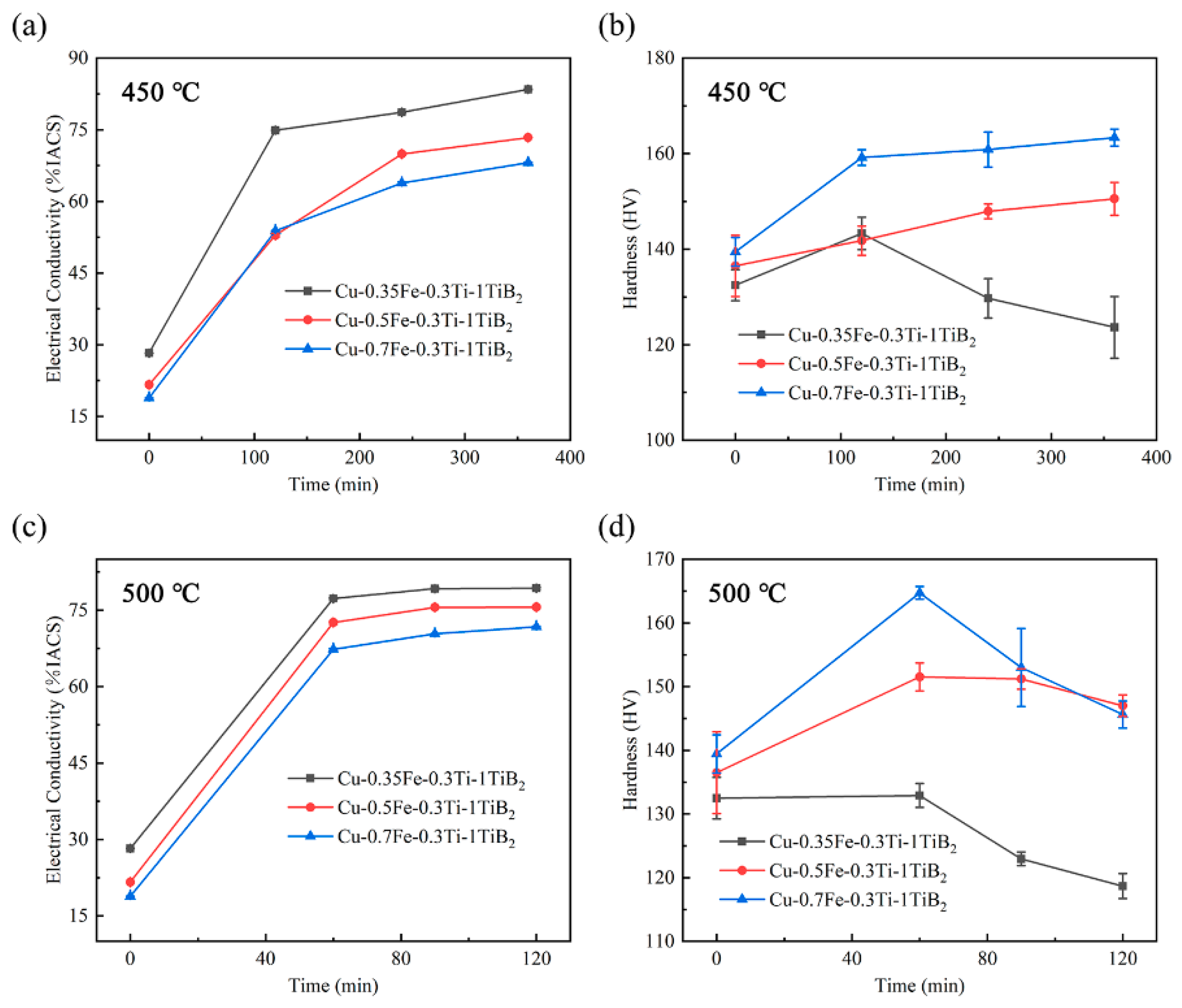

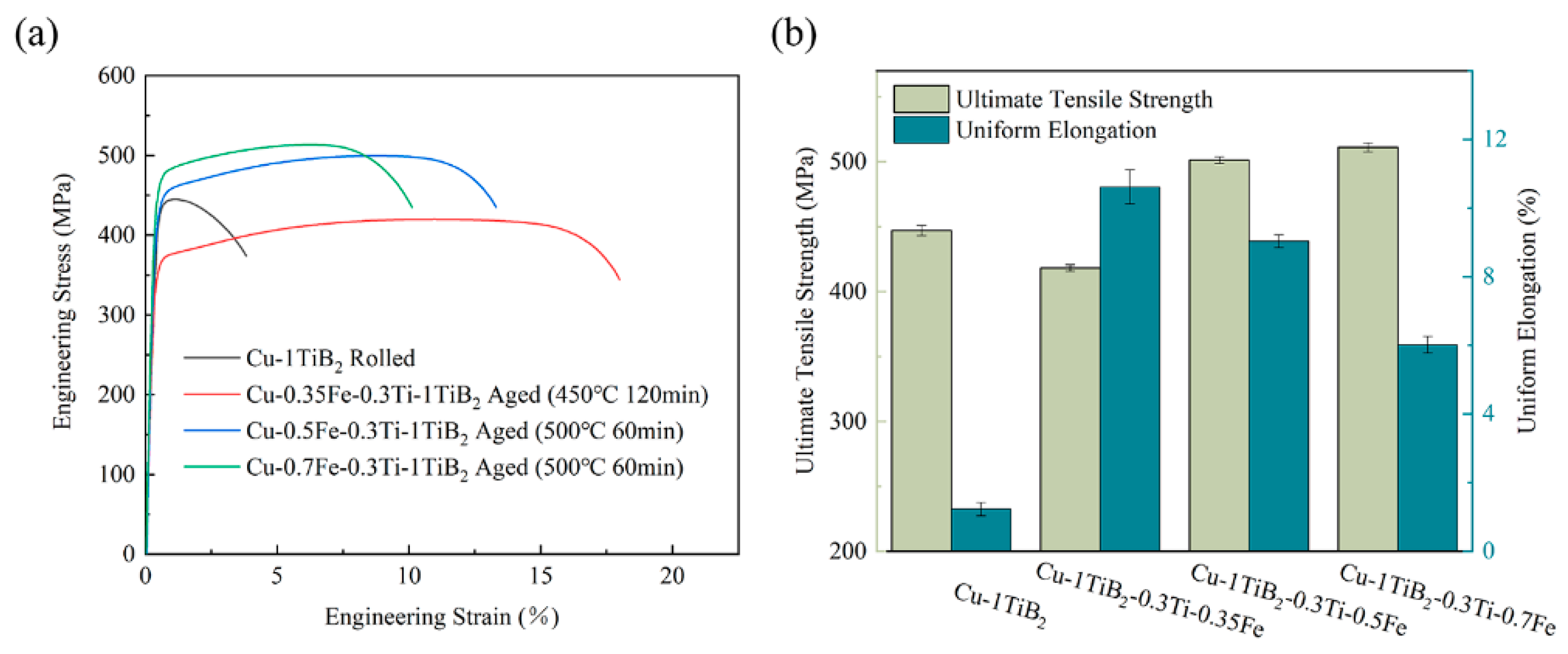

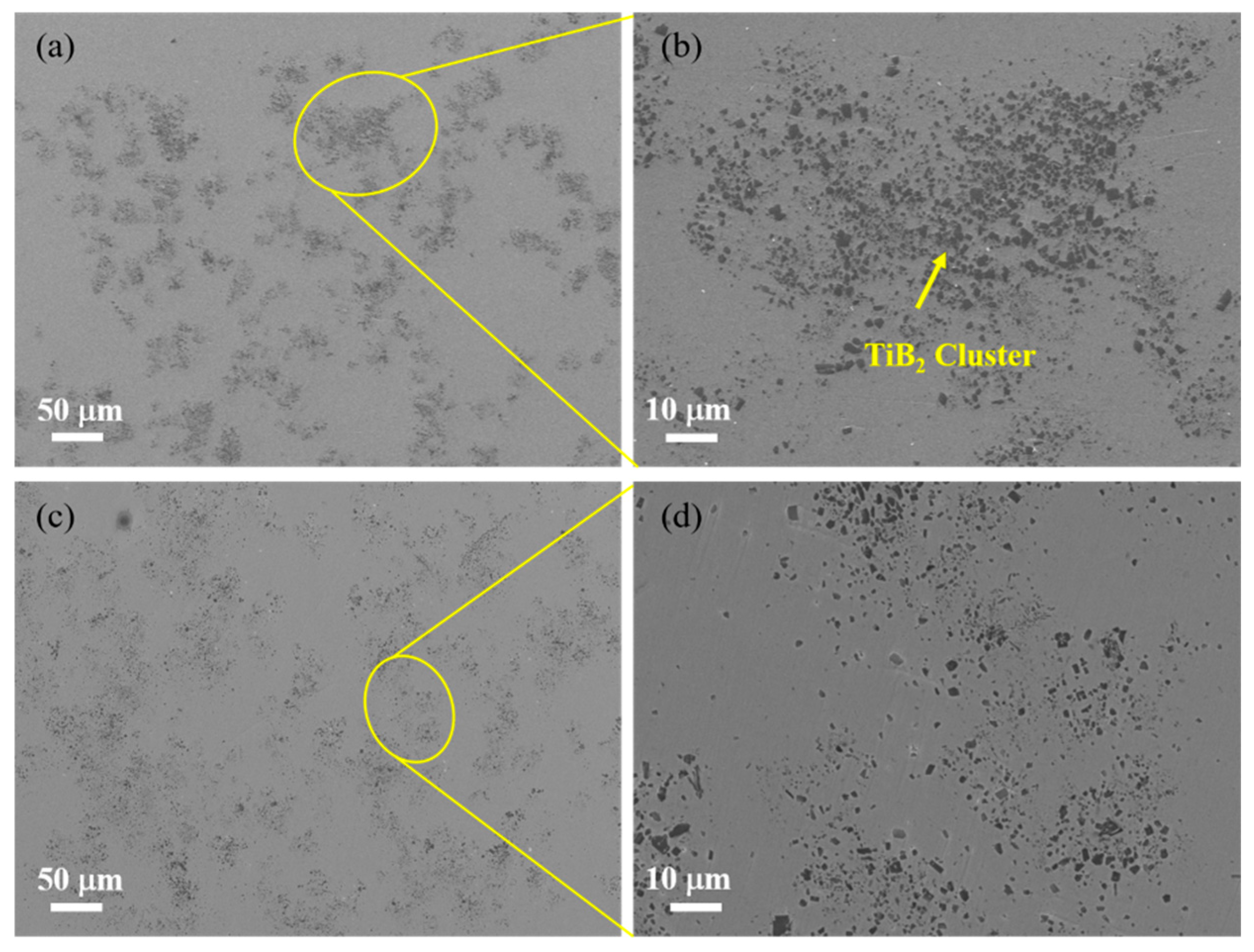
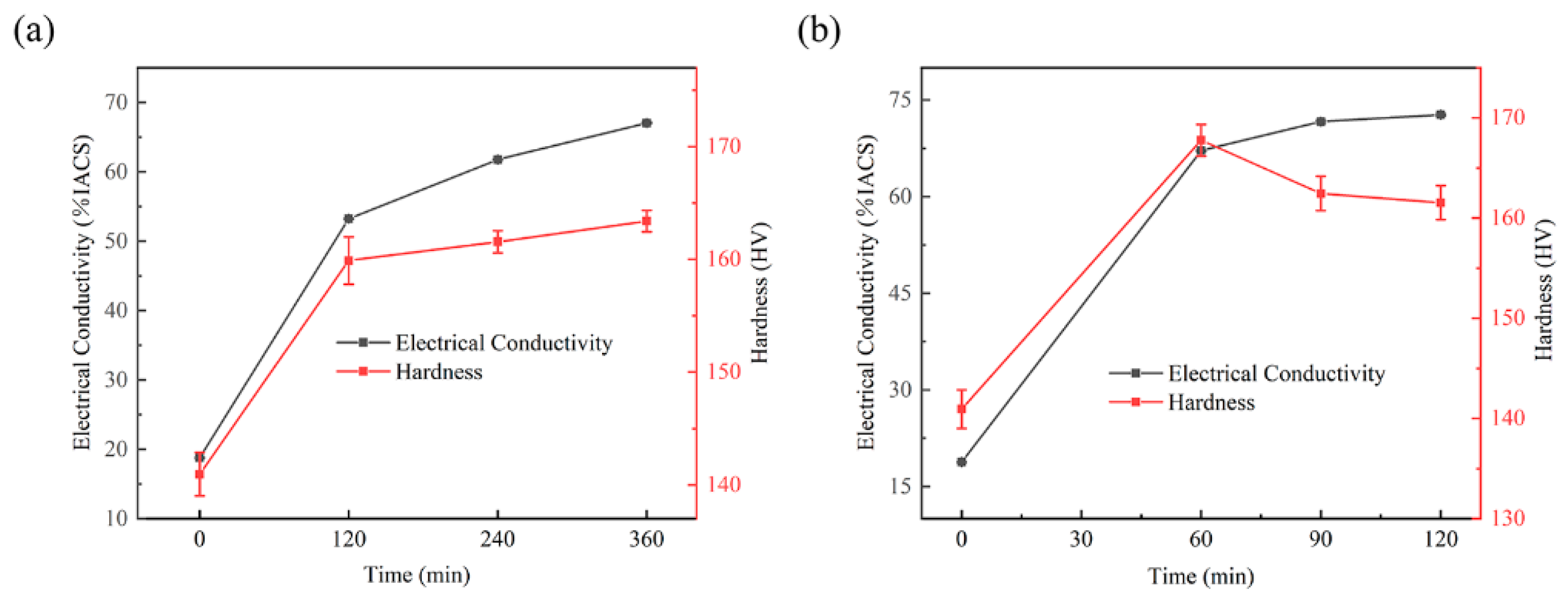


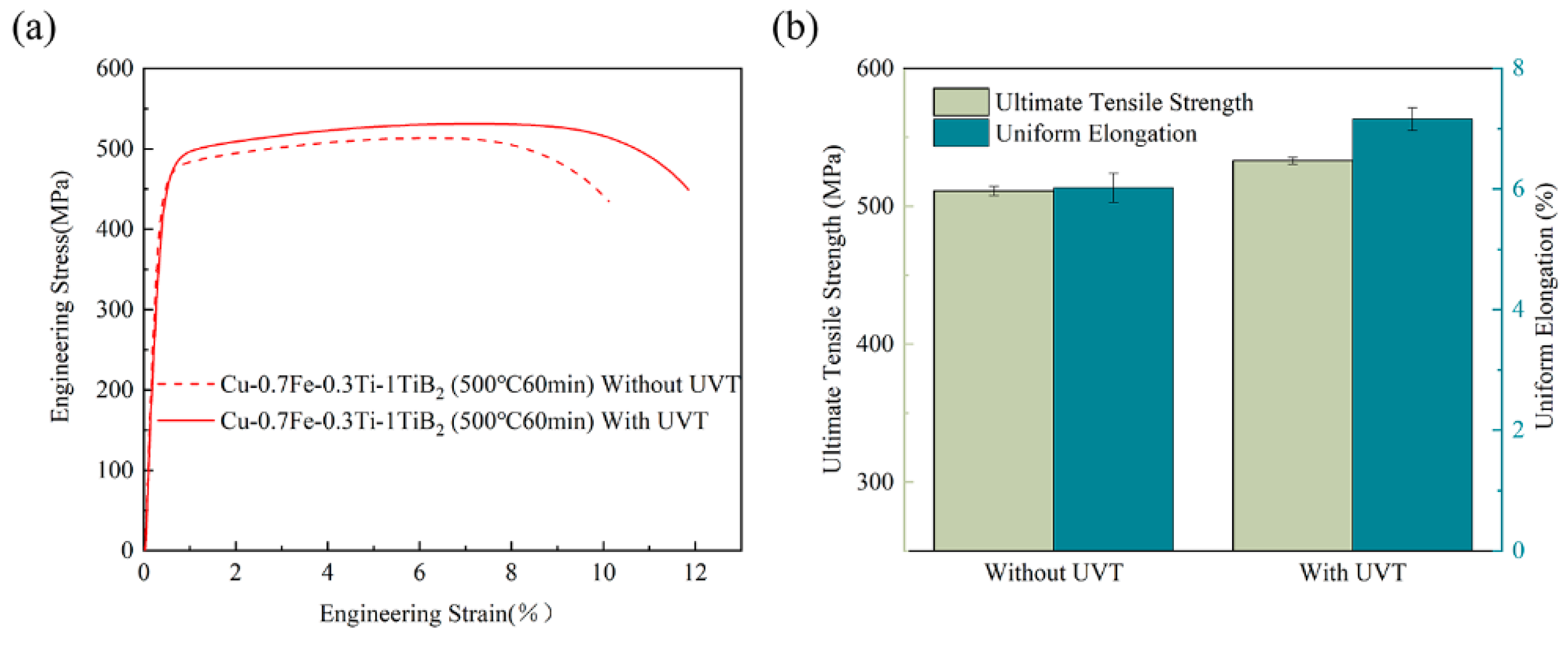

Disclaimer/Publisher’s Note: The statements, opinions and data contained in all publications are solely those of the individual author(s) and contributor(s) and not of MDPI and/or the editor(s). MDPI and/or the editor(s) disclaim responsibility for any injury to people or property resulting from any ideas, methods, instructions or products referred to in the content. |
© 2024 by the authors. Licensee MDPI, Basel, Switzerland. This article is an open access article distributed under the terms and conditions of the Creative Commons Attribution (CC BY) license (https://creativecommons.org/licenses/by/4.0/).
Share and Cite
Zhang, S.; Li, G.; Duan, C.; Qu, Y.; Cheng, M.; Dong, S. Effect of Fe Element and Ultrasonic Vibration on the Microstructure and Mechanical Properties of the Cu-TiB2 Composites. Metals 2024, 14, 1007. https://doi.org/10.3390/met14091007
Zhang S, Li G, Duan C, Qu Y, Cheng M, Dong S. Effect of Fe Element and Ultrasonic Vibration on the Microstructure and Mechanical Properties of the Cu-TiB2 Composites. Metals. 2024; 14(9):1007. https://doi.org/10.3390/met14091007
Chicago/Turabian StyleZhang, Siruo, Guanglong Li, Cunhu Duan, Yingdong Qu, Min Cheng, and Shulin Dong. 2024. "Effect of Fe Element and Ultrasonic Vibration on the Microstructure and Mechanical Properties of the Cu-TiB2 Composites" Metals 14, no. 9: 1007. https://doi.org/10.3390/met14091007



